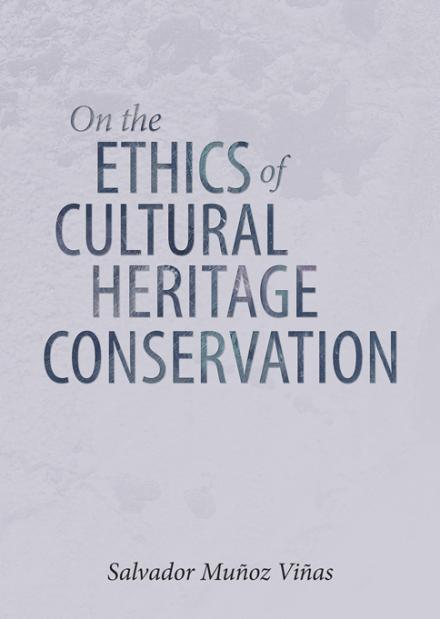Book Review: On the Ethics of Cultural Heritage Conservation
Submitted by sharragrow on

Review by Lisa Edgren
On the Ethics of Cultural Heritage Conservation
By Salvador Muñoz-Viñas
Archetype Publications Ltd, London, 2020
Paperback / 140 pages
ISBN10 1909492701 / ISBN13 9781909492707
As the field of cultural heritage is broadening, the role of conservation becomes more complex. “It is only by evolving that it [conservation] has been able to survive through the most turbulent 200 years in human history, and it would seem to be a good strategy for its survival into the future”, says Muñoz-Viñas (p. 8) in On the Ethics of Cultural Heritage Conservation.
With pictorial case-studies and captivating discussions, cultivated through an in-depth practical and theoretical knowledge of conservation, Muñoz-Viñas unfolds and deciphers some of the most complex issues in conservation ethics. Throughout 123 numbered pages, the scheme of conservation of cultural heritage is dismantled and reassembled. Clues to where the conservation profession is heading in the future are identified, as well as ideas on how to intentionally influence its direction.
This publication includes fifteen independent essays, bound together into nine chapters. Each chapter focuses on an ethical principle of conservation. Some essays are previously published papers, a few are texts originally written from lectures, and some are written especially for this publication. The reading is easy, varied, and entertaining. Especially engaging is The Patina Personality Test (pp. 42-43). To give the readers of NiC a hint of what this book is about and entice them to read it, I have summarised a few of my favourite parts.
The idea that conservation aims to uncover the “truth” of cultural heritage is successfully disassembled and examined in the essay “The Battle of Clio and Euterpe” (pp. 9-16). Three muses from Greek mythology are used to illustrate different natures of truth within conservation; historical nature is advocated by Clio, aesthetic nature is argued by Euterpe and hard science is preferred by Urania. The idea is that by identifying which muse we pay the most attention to, we can become aware of their influence on our decisions. By using the three muses, Muñoz-Viñas gives the reader a better understanding of the history of conservation ethics.
In the second chapter, on authenticity (pp. 17-30), a philosophical tautology and three case-studies highlight the discrepancy between how the word “authenticity” is used and what it means practically in conservation. Because authenticity refers to a hypothetical state in the object’s history, conservation can never make an object more authentic than it already is. Instead, authenticity is the relationship between the object´s history and what we believe the object´s history should be or what we expect it to be, concludes Muñoz-Viñas (p. 25). This chapter highlights the complexity of different expectations of authenticity within the conservation profession as well as the public. In a chapter on “The Shape of Things to Come” (pp. 109-114), it is suggested that the focus of conservation should be value and not authenticity.
Muñoz-Viñas continues to examine and develop discourses on common ethical principles in cultural heritage conservation. In the chapter “On Minimal Intervention” (pp. 53-62), he concludes that “minimal” intervention only refers to the negative effects of an intervention. Therefore, the more accurate term “balanced meaning loss” is suggested. In a chapter on conservation of the artist's intent (pp. 63-84), he reveals that this principle is weaker than it might seem initially. Firstly, the artist's intent and the impact of the artwork are often confused; what the artwork mediates might be what the artist intended, or it might not. Secondly, since time alters artworks, they will always change whether it is what the artist intended or not. In a chapter on conservation ethics (pp 99-107), he shows that common conservation principles are too strict and therefore routinely ignored. Instead, conservators silently apply consequential (goal-based) ethics.
The chapter “On Conservation” (pp 91-98) uses a case-study—the restoration of a cathedral which resulted in different parts of its history being exposed together as a whole—to question whether a restoration can be successful while at the same time produce something completely new. “In a way, it could be described as a sort of historical Frankenstein monster: after the restoration, the half-dome in the main chapel of the cathedral has become a new creation made from fragments of different origin”, says Muñoz-Viñas (p. 93).
As the cultural heritage sector is broadening, the identity of the conservation profession is evolving. Muñoz-Viñas views this development as an opportunity to impact the nature of its direction. I consider this publication the most important on the ethics of conservation since 2005, when the author published Contemporary Theory of Conservation. Muñoz-Viñas’ contribution to the discourse on the ethics of cultural heritage conservation is hard to overestimate.
Author Byline
Lisa Edgren holds an MSc with a major in conservation from the University of Gothenburg in Sweden. She is the head of the department for paper conservation at the Kiruna Centre for Conservation of Cultural Property (SFMV). SFMV provides conservation services for, among others, the Swedish National Archives and the National Library of Sweden.
(Read the review in the June-July 2021 "News in Conservation" Issue 84, p. 38-39)